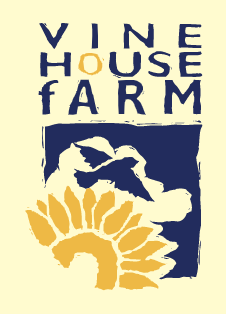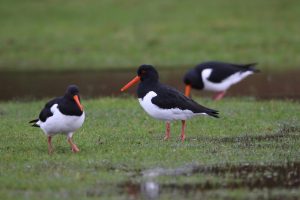
September has been a dry month with only 25mm, or an inch, of rain falling, but only four miles away in Baston Fen, over 50mm or 2ins had fallen, so it shows how different local rainfall can be. The average temperature has been 14.8°C, warmer than average, the 50-year average being 14.21°C.

Everyone had the fear that once it started raining, it would never stop. It really did start raining – we had rain on six consecutive days, then virtually no rain since. Autumn keeps progressing, every day gets shorter and every day the ground may get wetter and so the farmer has to keep cracking on to continue his cycle of production. We never know what the weather has in store for us – only three years ago in 2019, it was so wet we were only able to sow 50% of our winter wheat, while some farmers were not able to drill any.
Through September we have been cultivating and getting ready for sowing our winter wheat. As we’re not a normal farm, we have still a lot of harvesting to do which we have been concentrating on, as well as selling the remainder of last years potatoes. The 800 tons of red potatoes that we feared might go for cattle food increased in value because of the dry summer. Some were for general use and latterly they went for making potato powder, the last going on 26th September still in good condition.
All the potatoes we have grown this year were irrigated and before we start harvesting the potatoes all the aluminium pipes we used to convey the water have to be collected up. We have to stop the potatoes growing so that their skins will set fast. If the skins will still rub off, they will not keep very well. Previously we’ve used chemicals to do this, but as they are now banned, we now flail the tops off. We then have to wait three weeks for the skins to set. We arrived at that position on the 23rd September and are now harvesting them and putting them into store. They are a good crop and we are now selling extra large potatoes in our Farm Shop.
As September draws to a close, the millet has nearly all been harvested. With all the good weather, it should have been ready to harvest earlier, but when we wanted to sow it earlier in the year, there wasn’t enough moisture for it to grow. We had to wait until we had some rain in the second half of May. The sunflowers are a big seed, so we could drill them deeper into the moisture at the time when we normally sow them and they started growing immediately. They have enjoyed the above average sunshine that we have had and they will be ready for harvesting in the first week of October, earlier than usual.
Pigeons can move into our sunflowers during October and literally eat half of our crop. Fortunately they are not doing that yet. Although we don’t consider Wood Pigeons to be a migratory species, they are in most parts of Europe. They haven’t been studied much as they are not a declining species. but I do know that the Wood Pigeons that breed in Scandinavia migrate South and west to get away from the winter snows. Sometimes they keep going south and west on mainland Europe; other years, if there is a good easterly wind, they cross the North sea and come and aggravate the British farmers.


We don’t have much wildlife on the farm now; all the summer visitors have left us and the winter visitors haven’t arrived yet. Most of them slip away very quietly, they nearly all migrate at night to various places in Africa. Often they migrate to the exact place they wintered the year before; this we know because ornithologists, who have been attaching radio tags on birds, have been able to confirm this. When I was in Ghana 10 years ago, we caught a Nightingale with a radio tag that had been caught and tagged the year before, only 100m from where we caught it. The tag was taken off the bird, plugged into a lap top and we could see where it had been to since it was tagged – it had spent the summer in Italy.
Swallows and House Martins also slip away very quietly but they migrate during the day. Over the past few years I have become very interested in the arrival and departure of Swallows. I suppose you could say I have been interested in them for more than 60 years, as I have been recording their arrival and departure since I started keeping a diary in 1959. Then, and for the next 25 years, I could see Swallows and House Martins every day until the middle of October, and quite often later in the month. They then started to leave earlier and now the Swallows that breed here leave in the first few days of September. We continue to see Swallows for most of September but those are Swallows that have come from further north or even Scandinavia. In the 70s and 80s, Swallows would be collecting flies over our crops but with the continual spraying of our arable fields, the Swallows are now only able to find flies near livestock or over water.
Here on the farm we are able to watch Swallows migrating south west as they follow the Lincolnshire coast from Skegness to Boston. They continue flying south west following the River Welland and come across the farm. I have been able to point out Swallows flying south west to people. So interesting to see them, but so sad to think what is happening to our wildlife.
Seed eating birds have been moving to the millet and sunflower crops we have yet to harvest. Soon the standing crops will be harvested but the birds will still have the stubbles to pick over. If we can direct drill these fields, there will be another two or three months when food will be easily available for the following species: Starlings, Lapwings, Pheasants, Grey Lag Geese, Wood Pigeons, Stock Doves. I will of course be feeding birds around the farm again this winter, leaving food under the hedges for the smaller birds, but most of the above named species like to feed out in the open.
Barn Owls are doing well because there are lots of voles around, there has been very little wind and not much rain. They hunt by sound as well as sight, so windy conditions mean they can’t hear the voles in the long grass. Barn Owls don’t have waterproof feathers and rain drops make a noise, so no point in hunting in the rain. Next month I will know how the second broods have fared so more news later.



